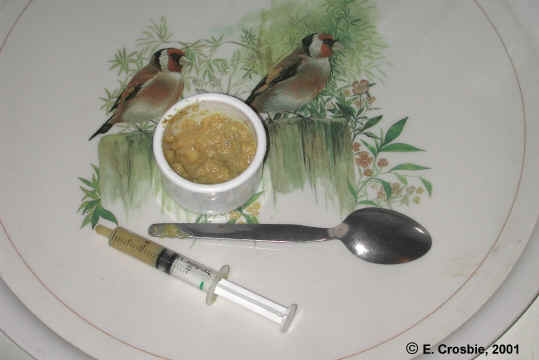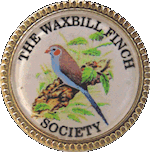When the Bengalese don't do their duty, almost invariably as the Pin-tailed Parrotfinch chicks
fledge, the only option is to hand feed (supplement) for a few days
With Pin-tailed Parrot Finches, keep fledglings being hand-fed with the
Bengalese. Often they resume fostering duties after a few days as the
chicks strengthen
Syringe - 5ml syringe best for balance of - nozzle size,
ease of filling and volume of food
Drill exit hole to 3mm, to minimise clogging
Sand or scrape inner ridge at inside top
of the barrel (designed to stop plunger coming right out)
You need plunger out when filling barrel with eggfood
Fix rubber end to plastic plunger handle with silicon
Stop rubber end coming off the plunger
A teaspoon handle makes a good spatula
The mix - take a heaped teaspoon of eggfood, remove large seeds
and crush to minimise large lumps which would clog the syringe. Later we used a
rolling pin for speed and volume done
Add a pinch of protein boost and probiotics
Mix with water until mix is quite sloppy. Leave for 2 or 3 minutes so the water
is absorbed
Add more water for a moist paste which is quite wet but when stirred doesn't run
Keep in fridge and only use for that day
Dip part of the syringe containing eggfood in hot water to warm for 5
minutes. Fill syringe with about 1ml per chick per feed
How much and how often - 4ml probably daily
maximum (2ml the minimum). Varies as the chicks age (less as get older)
Maximum probably better for first two days
Thereafter, a slightly hungry chick is better as will beg to the Bengalese and seek food
from the dishes
Active chicks are fed chicks. Feed any which close eyes after you have stood still
in bird room for two minutes
Be ruthless in the morning, once fledged for a few days, to encourage
begging and self-feeding
Once self-feeding you might supplement only 0.5ml per chick last thing at night until day
10 or even 12
1ml probably maximum at any one feed. Less than 0.5ml isn't worth doing
Evening feed the most important. Get at least 1ml in, even if takes
two feeds close together, so chick lasts the night
More frequent feeds better but have fed 1.2ml at 7.30am; 1ml at 4pm and 1.5ml
at 8pm. The chick was fine
How - chicks vary right from day one. There are
the beak clenchers, the chokers, the regurgitators, the fidgets and the
blissful - let's get this ml in ASAP!
Once syringe is in, food needs to fall behind the lip at the back of the
tongue. Don't depress the tongue as the flap at the back is used like a
paddle to swallow the food
I open the beak with sideways pressure from the end of the syringe. My
wife somehow opens the beak with her thumb
Syringe should enter slightly from one side to keep an air hole open
Pause for a bit to let the food go down
Judge the speed from the chick and pause if it shows distress. Choking
is obvious. Squirming is very different!
Pause if mouth is full with food oozing out the sides
I've only choked one chick out of 30 or 40 hand fed. That's
one too many
When the Bengalese don't do their duty, almost invariably as the Pin-tailed Parrotfinch chicks
fledge, only option is to hand feed for a few days
With Pin-tailed Parrot Finches, keep fledglings being hand-fed with the
Bengalese. Often they resume fostering duties after a few days as the
chicks strengthen
Syringe - 5ml syringe best for balance of - nozzle size,
ease of filling and volume of food
Drill exit hole to 3mm, to minimise clogging
Sand or scrape inner ridge at inside top
of the barrel (designed to stop plunger coming right out). You need plunger out when
filling barrel with eggfood
Fix rubber end to plastic plunger handle with silicon. Stops rubber end coming off plunger
A teaspoon handle makes a good spatula
The mix - take a heaped teaspoon of eggfood, remove large seeds
and crush to minimise large lumps which would clog the syringe
Later we used a rolling pin for speed and volume done
Add a pinch of protein boost and probiotic Mix with water until mix is quite sloppy
Leave for 2 or 3 minutes so the water
is absorbed. Add more water for a moist paste which is quite wet but when stirred
doesn't run. Keep in fridge and only use for that day
Dip part of the syringe containing eggfood in hot water to warm for 5
minutes. Fill syringe with about 1ml per chick per feed
How much and how often - 4ml probably daily
maximum (2ml the minimum). Varies as the chicks age (less as get older). Maximum
probably better for first two days
Thereafter, a slightly hungry chick is better as will beg to the Bengalese and seek food
from the dishes. Be ruthless in the morning, once fledged a few days, to encourage this
Active chicks are fed chicks. Feed any which close eyes after you have stood still
in bird room for two minutes
Once self-feeding you might supplement only 0.5ml per chick last thing at night until day
10 or even 12
1ml maximum at one feed. Less than 0.5ml isn't worth doing
Evening feed the most important. Get at least 1ml in, even if takes
two feeds close together, so chick lasts the night
More frequent feeds better but have fed 1.2ml at 7.30am; 1ml at 4pm and 1.5ml
at 8pm. The chick was fine
How - chicks vary right from day one. There are
the beak clenchers, chokers, regurgitators, fidgets and the
blissful - let's get this in ASAP!
Once syringe is in, food needs to fall behind the lip at the back of the
tongue. Don't depress the tongue as the flap at the back is used like a
paddle to swallow the food
I open the beak with sideways pressure from the end of the syringe. My
wife opens the beak with her thumb
Syringe should enter slightly from one side to keep an air hole open
Pause for a bit to let the food go down
Judge the speed from the chick and pause if it shows distress. Choking
is obvious. Squirming is very different!
Pause if mouth is full with food oozing out the sides
I've only choked one chick out of 30 or 40 hand fed. That's
one too many








